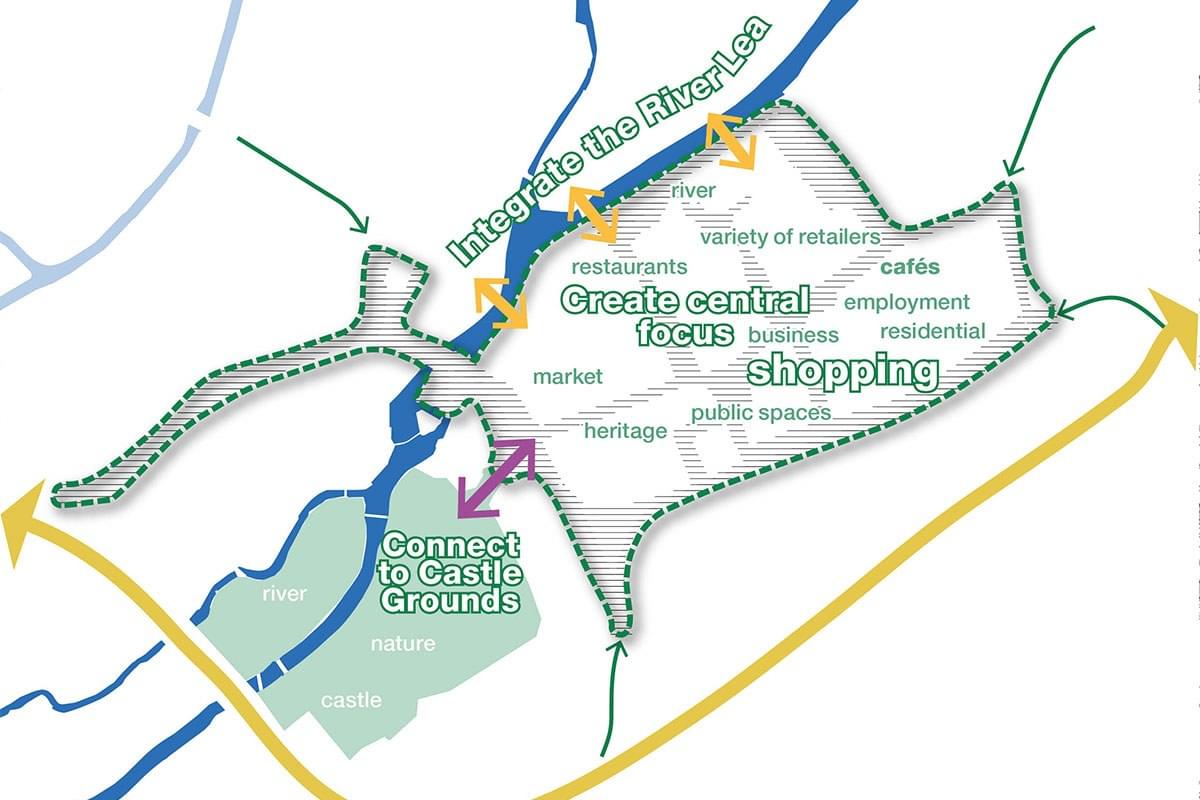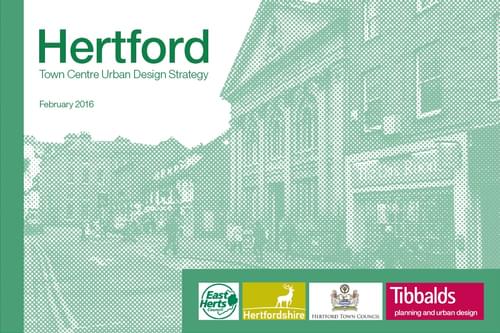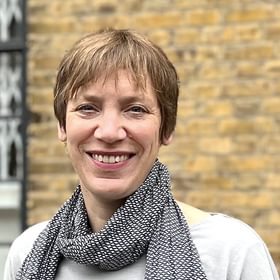Hertford Town Centre Strategy
A vision for diversity
Hertford is already a great town, our town centre strategy is designed to make it the best it can be and secure its status as the county town of Hertfordshire. Although focused on the town centre, the strategy will have a much wider reach by helping to solidify the role of Hertford in the wider Hertfordshire area.

- Project Deliverables:
- Hertford Town Centre Urban Design Strategy
- Client:
- East Herts District Council
- Collaborators:
- The Retail Group, Aspinall Verdi, JMP, Dally Henderson
- Location:
- Hertfordshire, England
- Status:
- Unanimous approval by Town, County and District Councils

A document that will act as an excellent spring-board for guiding development and bringing forward enhancement schemes for this unique environment
Tibbalds led a multi-disciplinary team to produce a town centre strategy for Hertford, an historic market town.
The town has many assets that are not currently being utilised: a beautiful river, historic character and high quality local employers such as the district council. The town centre was not delivering the range of facilities that competing towns in the district offer and spatially it did not make the most of its riverside location and historic buildings. The purpose of the strategy was to identify the potential role for the town that would offer a spatial strategy to bring the best out of Hertford.
The purpose of the study
The following extract from the client brief sets out the purpose of the study: “...prepare a Hertford Town Centre Urban Design Strategy, particularly to inform the future development of the town centre (taking into account economic, movement, and design considerations) and to support the preparation of the emerging District Plan to 2031...”
The overall purpose of the strategy was to provide a long-term coherent vision for the town centre’s design, management and maintenance.

Key Issues and how we managed them
Collaboration with three Councils
Town, County and District Council. Hertford suffered as a result of disconnected actions of the three Councils. All of them have a claim and responsibility for parts of the town centre environment. Historically the communication between these three stakeholders was poor and they often pulled in different directions. We worked jointly with all of them in order to ensure the strategy could be delivered. At times this was challenging, but proved successful in the end.

Defining role and character for the town as a whole
Technically, Hertford is a County Town. It is, and historically has been East Hertfordshire’s administrative centre. However, it is not the largest town in the District and feels and functions more like a Market town. The town’s aspiration versus the reality was an important issue to resolve. It required us to look at the whole town, its growth aspirations as well as the wider district and towns that were providing similar or competing services. Following engagement with the public and members we derived a vision statement that people could embrace and that reflected a realistic outlook. This allowed us to tailor the town centre strategy appropriately.
Repairing a fragmented retail offer
Operators trading on the perceived periphery areas felt disconnected from the town and not included in plans and proposals. By including the wider towns retailers and operators in the research process, we were able to fully understand the local issues, trading performance and the gaps in all sectors of offer. This enabled us to identify future growth potential and customer needs.
Delivering the right kind of development
While we were preparing the masterplan, proposals on a key opportunity site were promoted by a developer. This site was the only opportunity to introduce a wider town centre offer including leisure facilities, higher quality restaurants, reconnect the centre to the River Lea and provide a critical mass of modern retail units that could attract national stores. We prepared a series of options that were based on a robust evidence and were tested, from a retail and viability perspective. These provided the Council with a tool to negotiate with the developer and improve the proposals substantially.

Addressing ingrained highway issues
Not surprisingly, car parking and traffic were major concerns for the local community. Ironically, Hertford Town Centre had become a bypass to a ring road that originally had been built in the 1960s and suffers from substantial traffic congestion. In order to achieve the objectives for the town centre, this situation had to be changed. Working with the County Council, we proposed to close a street to become one-way traffic only. This helped to break the habit of using the town centre as rat-run and reduce traffic within the town centre significantly – enough to allow key streets and spaces to be pedestrian priority areas and enable them to be closed off temporary for markets or community events.

Successful Outcomes
Collaborative working between the three Councils
The process of engagement with the Councils was successful and members of all three Councils have unanimously agreed the final urban design strategy. Moreover, they also set up a joint delivery group and pledged funds in order to deliver the vision.
Improving development proposals to contribute positively to the wider town
Originally, the developer had proposed a scheme led by a large foodstore with surface car park. The final scheme informed by our evidence base, options and masterplan delivered a higher density scheme, included a variety of retail and leisure units, substantial amounts of residential and addressed the river Lea in a positive manner, integrating it positively into the wider town centre. It also embraced the bus station as a driver for increased footfall, rather than turning its back on it.


Connecting the centre to the wider town
The public realm strategy proposed interventions to improve the connectivity to opportunity sites where significant growth was taking place, around the station to aid way-finding as well as improving connectivity between different areas and destinations.
Re-focusing the town centre around the pedestrian
While, initially, there had been strong opposition to the plans to restrict car movement, the justifications provided by the masterplan generated enough buy-in, so that the Councils made a commitment to install a temporary road closure to ascertain the impact on the wider highway network.
Enabling progress
When we started the study, a number of town centre sites had been vacant for some time and the Councils were unable to bring forward improvement projects. The process of undertaking the study and engagement with stakeholders led to significant progress. Two of the three opportunity sites were developed, buildings that had been vacant were being refurbished and a public realm project was finally being progressed.
Positive improvements
The Strategy has been unanimously approved by the three Councils and led to the delivery of public realm improvements and a programme of Council led development works to improve the local leisure offer.
Core Team
Below are some of the key people that worked on this project.

Start the conversation...
Learn more about this project and our town centre experience by contacting Katja Stille
Call Katja on 0207 089 2121 or email katja.stille@tibbalds.co.uk